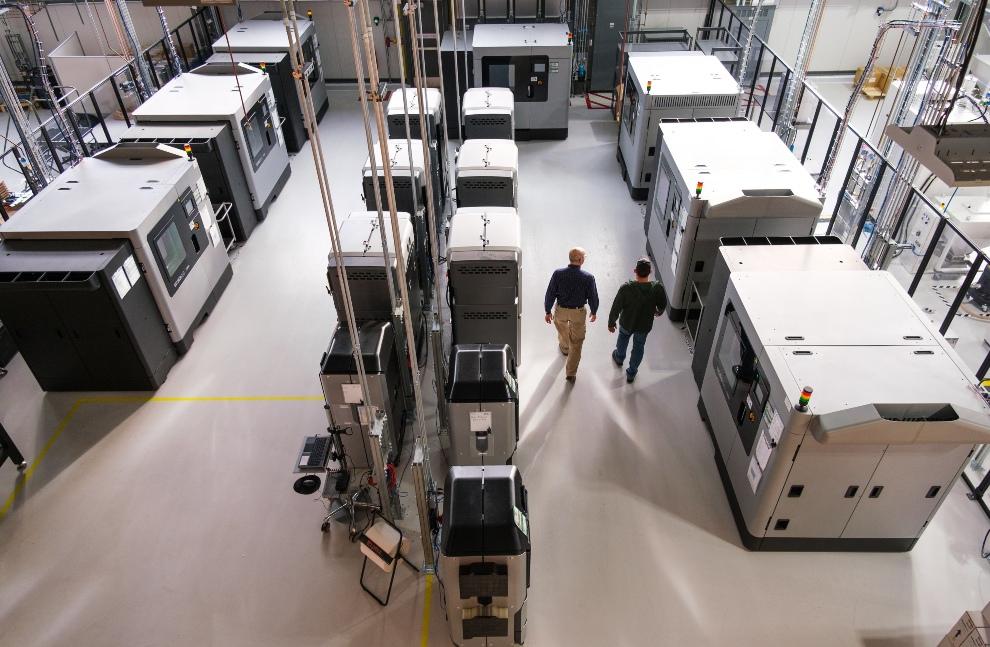- FMA
- The Fabricator
- FABTECH
- Canadian Metalworking
Our Publications
Categories
- Additive Manufacturing
- Aluminum Welding
- Arc Welding
- Assembly and Joining
- Automation and Robotics
- Bending and Forming
- Consumables
- Cutting and Weld Prep
- Electric Vehicles
- En Español
- Finishing
- Hydroforming
- Laser Cutting
- Laser Welding
- Machining
- Manufacturing Software
- Materials Handling
- Metals/Materials
- Oxyfuel Cutting
- Plasma Cutting
- Power Tools
- Punching and Other Holemaking
- Roll Forming
- Safety
- Sawing
- Shearing
- Shop Management
- Testing and Measuring
- Tube and Pipe Fabrication
- Tube and Pipe Production
- Waterjet Cutting
Industry Directory
Webcasts
Podcasts
FAB 40
Advertise
Subscribe
Account Login
Search
General Motors opens a new facility dedicated to 3D printing
GM’s Additive Industrialization Center houses 24 3D printers for making plastic and metal parts
- December 29, 2020
- Article
- Additive Manufacturing
General Motors announced in mid-December the opening of its 15,000-sq.-ft. Additive Industrialization Center (AIC), a ground-up facility dedicated to making 3D printing an accepted production method within the automotive industry.
The AIC exemplifies GM’s growing expertise and increased investment in 3D printing during the past few years, according to a company press release.
“The core component of GM’s transformation is becoming a more agile, innovative company, and 3D printing will play a critical role in that mission,” said GM Director of Additive Design and Materials Engineering Audley Brown. “Compared to traditional processes, 3D printing can produce parts in a matter of days versus weeks, or months, at a significantly lower cost.”
Many styles of printers
The facility houses 24 3D printers—both polymer and metal styles. They include selective laser sintering, selective laser melting, Multi Jet Fusion, and fused filament fabrication.
Earlier this year, in the beginning days of the COVID-19 pandemic, GM shared how 3D printing played a critical role in the company’s transition from making vehicles to medical devices in a matter of days, and how 3D-printed parts support rigorous motorsports competitions. These same processes are also transforming the company’s automaking operations.
“GM is increasingly applying the benefits of 3D printing, from prototype development to manufacturing tooling and production vehicles,” said GM Director of Additive Manufacturing and Polymer Centers Ron Daul. “With the opening of the AIC, we’ll continue to accelerate adoption of this technology across the organization.”
Functional prototypes
GM has a history of using 3D-printed prototypes to check form and fit. Today, many of the parts the AIC produces are functional prototypes used on preproduction vehicles in various testing environments.
These prototypes help lower tooling costs. As a result, engineers have the ability to iterate quickly, make design changes more easily, and reduce development times. For example, the team 3D-printed the brake cooling ducts used for developing the new Chevrolet Corvette. The 3D-printed ducts saved nine weeks of development and reduced costs by over 60 percent.
GM also is producing a significant number of 3D-printed tools for assembling vehicles. These include hand tools and automation-related components. 3D printing often lets the team consolidate the components of a part into a single, optimized design. The result is lighter, more ergonomic tools having simpler designs.
For the launch of GM’s all-new full-size SUVs, the team 3D-printed nearly 100 hand tools for the body shop at Arlington (Texas) Assembly. These tools typically would be made of aluminum and weigh anywhere from 10 to 40 lbs. The new designs, constructed from a nylon-carbon-fiber composite, weigh as little as 3 lbs. apiece and have virtually eliminated the lead time for ordering part changes.
“3D printing the body shop tools at Arlington saved more than two months in tooling construction,” said Daul. “This is at the critical time when we are changing the plant over to launch the new models. Ultimately, 3D printing helps accelerate new vehicle launches like our full-size SUVs.”
About the Publication
- Podcasting
- Podcast:
- The Fabricator Podcast
- Published:
- 04/30/2024
- Running Time:
- 53:00
Seth Feldman of Iowa-based Wertzbaugher Services joins The Fabricator Podcast to offer his take as a Gen Zer...
- Trending Articles
- Industry Events
Pipe and Tube Conference
- May 21 - 22, 2024
- Omaha, NE
World-Class Roll Forming Workshop
- June 5 - 6, 2024
- Louisville, KY
Advanced Laser Application Workshop
- June 25 - 27, 2024
- Novi, MI
Precision Press Brake Certificate Course
- July 31 - August 1, 2024
- Elgin,




























